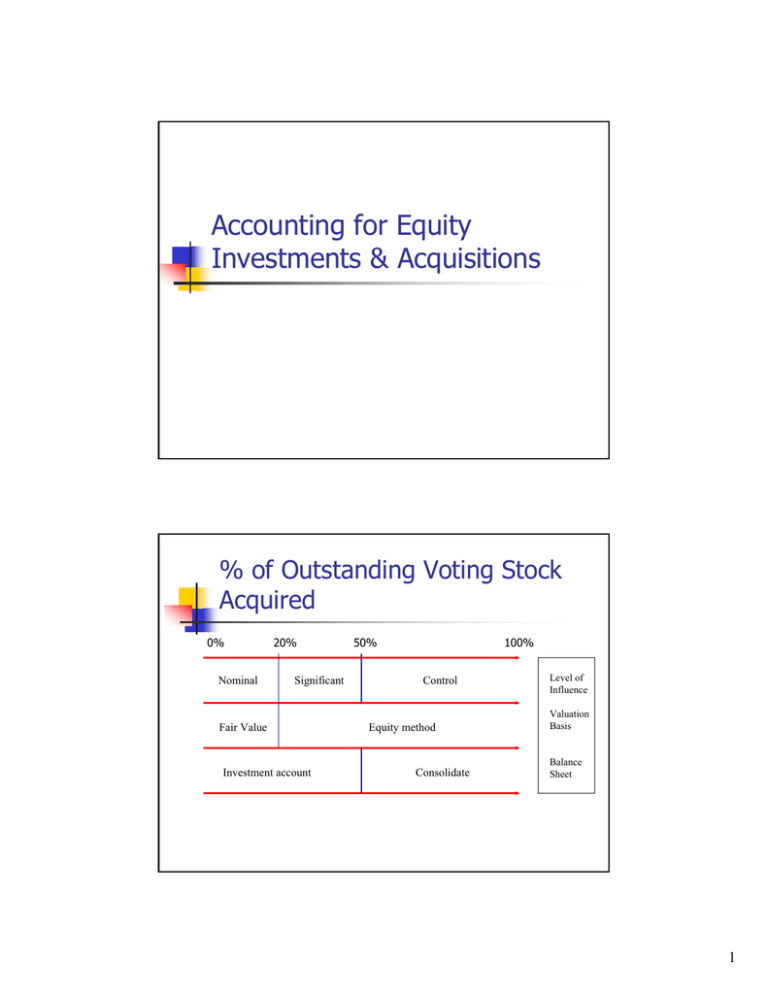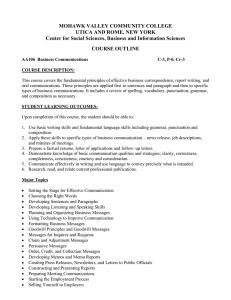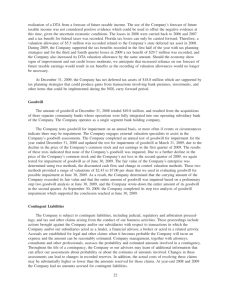Accounting for Equity Investments & Acquisitions % of Outstanding Voting Stock Acquired
advertisement

Accounting for Equity Investments & Acquisitions % of Outstanding Voting Stock Acquired 0% Nominal 20% Significant Fair Value Investment account 50% 100% Control Equity method Consolidate Level of Influence Valuation Basis Balance Sheet 1 Equity Method - Introduction Records the initial purchase of an investment at acquisition cost Each period, the investor captures its proportionate share of the periodic earnings Not the dividends of the investee Investor treats dividends declared by the investee Reduction in the investment account. Equity Method - Rationale Why not mark-to-market such investments? Under the market value method for securities available for sale, the investor recognizes income statement effects only when it receives a dividend (revenue) or sells some of the investment (gain or loss). 2 Example – Equity Method 12/31/2003 XYZ Inc. purchases 40% of the outstanding shares of ABC Inc. for $1.2M Book value of ABC = market value at this date ($ 3M) At 2004 ABC reports income of $250,000 and pays dividend of $100,000 At 2005 ABC reports earnings of $500,000 and pays dividends of $225,000 How and in what amount should this investment be presented on XYZ’s balance sheet on December 31, 2004 and 2005? Journal Entries: At the Acquisition Date Investment in ABC’s stock 1,200,000 Cash 1,200,000 Record the acquisition of 40% of ABC Inc. 1,200,000=40% x 3,000,000 3 Year 2004 Investment in ABC stock 100,000 Equity in Earnings of Affiliate 100,000 To record XYZ’s share in the income earned by ABC Cash Investment in ABC stock 40,000 40,000 To record dividends received from ABC Year 2005 Investment in Stock of ABC 200,000 Equity in Earnings of Affiliate 200,000 To record XYZ’s share in the income earned by ABC Cash 90,000 Investment in Stock of ABC 90,000 To record dividend received from ABC. 4 Balance Sheet Looks Like… Firm XYZ’s “Investment in ABC” account now has a balance of $1,370,000 by the end of 2005: Investment in Stock of ABC (1) 1,200,000 (2) 100,000 (4) 200,000 40,000 (3) 90,000 (5) Balance 1,370,000 Consolidation Accounting In a business combination, one company (Parent) gains control over another company (Subsidiary) Until 2001, two consolidation methods were used for mergers and acquisitions Purchase method Pooling of interests method In 2001, the FASB discontinued the pooling method (Statement 141) 5 Meaning of Control An entity that has the ability to elect a majority of the board of directors of another entity has control over it Control enables the parent: Direct the sub to expand, contract or distribute cash to the parent Establish the sub financing structure Fire and hire the sub management Set compensation level for the sub management. Means of Control Legal Control Owning more than 50% of the subsidiary’s outstanding voting stock Parent has the legal right to elect the majority of the board of directors Effective Control Majority of the board of directors can be elected by means other then having legal control. 6 Three Categories of Combination Merger One firm acquires the assets and liabilities of one or more other firms in exchange for cash, stock or other compensation Acquired firm ceases to exist as a separate legal entity 100% ownership Three Categories of Combination… Statutory Consolidation New firm is formed to issue stock in exchange for the stock of the two or more consolidating firms Acquired firms cease to exist as separate legal entities 100% ownership. 7 Three Categories of Combination… Acquisition One firm acquires the majority of the common stock of another company and each company continues its legal existence Each company must be accounted for separately and prepare its own set of financial statements Financial statements are then consolidated Consolidated financial statements - combination of the financial statements of the parent company with those of the subs an overall report as if they were a single entity Consolidation Process Eliminating worksheet entries are made to reflect the two separate companies’ statements as one economic entry No consolidation elimination entries are recorded on the books of either the parent or the subsidiary. 8 Consolidation - Rationale Economically, the parent has the power to liquidate the subsidiary into a branch In this case the current legal structure of two separate companies will cease to exist. Thus, the parent and the sub are treated as a single legal entity. Purchase Method Business combinations Use the purchase method Acquisitions are measured on the basis of the fair values exchanged. 9 Consolidation: Wholly-Owned Subsidary Before the purchase A Shareholders B Shareholders A Corporation B Corporation After the Purchase A Shareholders A Corporation B Corporation Wholly-Owned Subsidiaries Parent’s perspective Purchase Î exchange of one asset for another, usually cash for the stock of the subsidiary Consolidated net income = parent’s net income. Consolidated retained earnings = parent’s retained earnings Sub.’s retained earnings Eliminated in consolidation. 10 Partially-Owned Subsidiaries If parent company owns < 100% of sub Minority interest exists Calculated using book value of acquired firm Balance sheet reflects the rights of non-majority shareholders in the assets and liabilities of a company that is consolidated into the accounts of the major shareholder Appears after long-term debt but before stockholders’ equity (quasi liability). Minority income Income statement Î reflects the share of non-majority shareholders in the earnings of a the consolidated firm Appears as a line item deduction. Consolidation – 80% Owned Sub Before the Purchase A Shareholders B Shareholders A Corporation B Corporation After the Purchase A Shareholders A Corporation B Corporation Some of former B shareholders hold 20% of B 11 Purchased Goodwill Goodwill Excess of the cost of an acquired company over the sum of the fair market value of its net identifiable individual assets Goodwill usually results from one or more of the following: Brand name Good employees Customer loyalty Monopoly power. Recognition & Measurement of Goodwill Dictated by Statement No. 142: Goodwill and Other Intangible Assets (July 20, 2001) Goodwill should not be amortized Tested for impairment at a level of reporting referred to as a reporting unit Reporting unit Î operating segment or one level below an operating segment A component of an operating segment is a reporting unit if the component constitutes a business for which discrete financial information is available and segment management regularly reviews the operating results of that component Impairment Î exists when the carrying amount of goodwill exceeds its implied fair value. 12 “Negative” Goodwill When the fair market value of the assets acquired exceeds the acquisition cost, the excess is first used to reduce the carrying value of noncurrent, nonfinancial assets. If such assets are reduced to zero, any additional amount is recognized as extraordinary gain. Grasping the Intangible Article provides a better perspective of goodwill than defined by accountants Consistent with the economic concept of economic value added or abnormal profits Turn to the article. 13 Acquisition Costs for R&D Using arcane accounting rule to get rid of goodwill Write-off as “purchased R&D” Acquirer sets price of “in-process” R&D assets and immediately writes them off No guidelines on valuation of research Many companies writing off > 50% of acquisition cost Problem Overstates ROE since equity written off. Goodwill: Impairment Test Goodwill of a reporting unit should be tested for impairment on an annual basis and between annual tests in certain circumstances Annual goodwill impairment test may be performed any time during the fiscal year provided the test is performed at the same time every year Different reporting units may be tested for impairment at different times. 14 Impairment Test – Step 1 Compare the fair value of a reporting unit with its carrying amount, including goodwill Fair value of a reporting unit > carrying amount Goodwill of the reporting unit is not impaired 2nd step of the impairment test is unnecessary Carrying amount of a reporting unit > fair value 2nd step of the goodwill impairment test performed. Impairment Test – Step 2 Compares the implied fair value of reporting unit goodwill with the carrying amount of that goodwill Carrying amount of reporting unit goodwill > implied fair value of that goodwill After a goodwill impairment loss is recognized Impairment loss = excess. Loss recognized cannot exceed the carrying amount of goodwill Adjusted carrying amount of goodwill is its new accounting basis Subsequent reversal of a previously recognized goodwill impairment loss is prohibited. 15 Goodwill Impairment: Triggering Events Goodwill of a reporting unit should be tested for impairment between annual tests if an event occurs or circumstances change that would more likely than not reduce the fair value of a reporting unit below its carrying amount. Examples of Triggering Events Significant adverse change in legal factors Adverse action or assessment by a regulator Unanticipated competition Loss of key personnel More-likely-than-not expectation that a reporting unit or a significant portion of a reporting unit will be sold or otherwise disposed of Recognition of a goodwill impairment loss in the financial statements of a subsidiary that is a component of a reporting unit. 16 Financial Statement Presentation Aggregate amount of goodwill Presented as a separate line item in the balance sheet Aggregate amount of goodwill impairment losses Presented as a separate line item in the income statement before the subtotal income from continuing operations (or similar caption) unless a goodwill impairment loss is associated with a discontinued operation Goodwill impairment loss associated with a discontinued operation should be included (on a net-of-tax basis) within the results of discontinued operations. Pooling of Interests Under APB 16, business combinations were accounted for using one of two methods, the pooling-of-interests method (pooling method) or the purchase method Use of the pooling method was required whenever 12 criteria were met; otherwise, the purchase method was to be used Pooling accounting is no longer allowed. 17 The End 18





